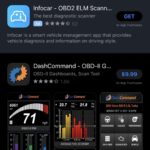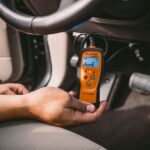The ubiquitous OBD2 port, a feature now standard in virtually every car on the road, has become synonymous with vehicle diagnostics and the burgeoning world of connected car technology. For those in the automotive repair industry, fleet management, or even just curious car owners, understanding this port and its capabilities is increasingly essential. But Where Does Obd2 Come From? The journey of OBD2 from its inception to its current prominence is a fascinating tale of regulatory necessity, engineering innovation, and a drive towards standardized vehicle communication. This article will delve into the history of OBD2, tracing its roots and evolution to provide a comprehensive understanding of its origins and significance in today’s automotive landscape.
The Genesis of On-Board Diagnostics: From OBD to OBDII
To understand where OBD2 comes from, we must first look back at its predecessor, OBD, or On-Board Diagnostics. The earliest forms of on-board diagnostics were born out of a growing need to monitor vehicle emissions. In the rapidly industrializing world of the mid-20th century, air quality became an increasing concern, particularly in densely populated areas like California. Recognizing the significant contribution of vehicle emissions to air pollution, regulatory bodies began to explore ways to control and reduce these harmful outputs.
Initially, manufacturers employed rudimentary diagnostic systems, often unique to each brand and even model. These early OBD systems were not standardized and offered limited diagnostic capabilities. They were primarily designed to alert technicians to potential issues, but accessing and interpreting the data was often complex and manufacturer-specific. This lack of uniformity posed significant challenges for repair technicians and hindered effective emissions monitoring.
The transition to OBDII marked a significant leap forward. OBDII, the second generation of on-board diagnostics, was conceived to address the limitations of its predecessor and to create a standardized system that would be universally applicable across different vehicle makes and models. This standardization was driven by regulatory mandates and the collective efforts of industry bodies aiming for greater efficiency and accessibility in vehicle diagnostics.
The Pivotal Role of Regulatory Bodies and Standards
The question of where OBD2 comes from is inextricably linked to the influence of key regulatory bodies and standard-setting organizations. The California Air Resources Board (CARB) stands out as a pioneering force in the development of OBD standards. Driven by California’s severe air quality issues, CARB spearheaded the push for mandatory on-board diagnostics. Their regulations in the late 1980s and early 1990s were instrumental in setting the stage for OBDII.
Alongside CARB, organizations like the Society of Automotive Engineers (SAE), the International Organization for Standardization (ISO), and the Environmental Protection Agency (EPA) played crucial roles in defining the technical specifications and protocols for OBDII. The SAE, in particular, was instrumental in recommending a standardized diagnostic connector and a uniform set of diagnostic test signals, paving the way for interoperability and ease of access. The EPA, at the federal level, also contributed significantly to the mandate and standardization of OBDII in the United States.
This collaborative effort between regulatory bodies and industry standards organizations was essential in shaping where OBD2 comes from and ensuring its widespread adoption. It was a response to a clear need for standardized emissions monitoring and diagnostics, driven by environmental concerns and the desire for more efficient vehicle maintenance.
Key Milestones in OBDII History: A Timeline
Understanding where OBD2 comes from requires examining the key milestones in its historical development. The evolution of OBDII was a gradual process, marked by significant technological advancements and regulatory decisions:
-
1968: Volkswagen introduces the first known on-board computer system with scanning capability. This marks an early step towards computerized vehicle diagnostics.
-
1978: Datsun (now Nissan) implements a basic OBD system. While limited and non-standardized, it demonstrates the growing industry interest in on-board diagnostics.
-
1979: The Society of Automotive Engineers (SAE) takes a crucial step by recommending a standardized diagnostic connector and a set of diagnostic test signals. This recommendation lays the groundwork for future standardization efforts.
-
1980: General Motors (GM) develops a proprietary interface and protocol. This system allows engine diagnostics via an RS-232 interface or, more simply, through the flashing of the “Check Engine Light.”
-
1988: Standardization efforts gain momentum with the 1988 SAE recommendation calling for a standard connector and diagnostics set. This is a pivotal moment in where OBD2 comes from, signaling a move towards industry-wide uniformity.
-
1991: California mandates basic on-board diagnostics (OBD I) for all vehicles sold in the state. This regulatory push is a significant step towards making on-board diagnostics a standard feature.
-
1994: California takes the lead again, mandating OBDII for all vehicles sold in the state starting in 1996, aligning with SAE recommendations. This mandate, driven by the need for comprehensive emissions testing, is a defining moment in where OBD2 comes from. OBDII includes standardized Diagnostic Trouble Codes (DTCs), making fault diagnosis more consistent and accessible.
-
1996: OBD-II becomes mandatory for all cars manufactured for sale in the United States. This federal mandate solidifies OBDII as the standard for vehicle diagnostics across the country.
-
2001: EOBD (European On-Board Diagnostics), the European equivalent of OBDII, becomes mandatory for all gasoline vehicles in the European Union (EU). This marks the global expansion of standardized on-board diagnostics.
-
2003: EOBD expands to include all diesel vehicles in the EU, further broadening the reach of standardized diagnostics.
-
2008: A further refinement of OBDII in the US requires all vehicles to implement OBDII via a Controller Area Network (CAN) as specified by ISO 15765-4. This update enhances the communication protocol and data transfer capabilities of OBDII systems.
This timeline clearly illustrates where OBD2 comes from: a gradual evolution driven by regulatory pressure, technological advancements, and a collaborative effort to standardize vehicle diagnostics for improved emissions control and vehicle maintenance.
Why Standardization Was Crucial: Before OBDII
Before the advent of OBDII, the landscape of vehicle diagnostics was fragmented and inefficient. Manufacturers developed their own proprietary systems, leading to a chaotic environment for technicians. Each system came with:
- Unique connector types: Mechanics needed a vast array of connectors to interface with different vehicles, increasing costs and complexity.
- Proprietary electronic interface requirements: Diagnostic tools had to be specifically designed for each manufacturer, limiting interoperability and driving up equipment costs.
- Custom fault codes: Interpreting diagnostic information was challenging as each manufacturer used their own custom codes for reporting problems. A code from one manufacturer would be meaningless on a vehicle from another.
This lack of standardization made vehicle repair more time-consuming, expensive, and difficult. Independent repair shops struggled to keep up with the diverse range of diagnostic systems, often limiting their ability to service vehicles effectively. The move to OBDII standardization was therefore essential to streamline vehicle diagnostics, reduce costs, and improve the efficiency of the automotive repair industry. It also ensured consistent and reliable emissions monitoring across all vehicles.
OBDII’s Impact and Evolution Beyond Emissions
While initially driven by emissions regulations, the impact of OBDII extends far beyond environmental concerns. The standardized OBDII port provides access to a wealth of vehicle data, proving invaluable for various applications:
-
Enhanced Vehicle Repair: Mechanics can quickly and accurately diagnose malfunctions using standardized diagnostic trouble codes (DTCs). This leads to faster repair times, reduced costs for vehicle owners, and more efficient workshop operations. Connecting a scanning tool to the OBDII port allows for immediate access to trouble codes and status information related to the powertrain and emission control systems.
-
Telematics and Fleet Management: The OBDII port is a critical enabler for telematics systems. Devices connected to the OBDII port can silently gather data on engine performance, vehicle speed, fuel consumption, driving behavior, and fault codes. This data is crucial for fleet management, allowing businesses to track vehicle health, optimize routes, monitor driver behavior, and improve overall efficiency.
-
Data Accessibility: OBDII provides access to essential vehicle information such as the Vehicle Identification Number (VIN), calibration identification numbers, ignition counters, and emissions control system counters. This data is valuable for vehicle history reports, emissions testing, and various other automotive applications.
-
WWH-OBD and Future Expansion: The evolution of OBD continues with initiatives like WWH-OBD (World Wide Harmonized On-Board Diagnostics). WWH-OBD aims to further standardize and enhance diagnostic capabilities by incorporating Unified Diagnostic Services (UDS) and expanding the range of accessible data. This evolution ensures that vehicle diagnostics remains relevant and adaptable to the increasing complexity of modern vehicles.
The Location of the OBDII Port: A Standardized Connector
A practical aspect of where OBD2 comes from and its standardization is the standardized location of the OBDII port itself. Typically located on the underside of the dashboard on the driver’s side of the vehicle, the OBDII port is designed for easy access. This standardized placement ensures that technicians and devices can readily connect to the diagnostic system without needing to search for proprietary connectors in obscure locations. While the pin configuration (16-pin, 6-pin, or 9-pin) may vary depending on vehicle type, the general location remains consistent across most passenger vehicles.
Conclusion
The journey of OBD2, answering the question of where does OBD2 come from, is a testament to the power of standardization and the crucial role of regulatory bodies in driving technological advancements. From its humble beginnings as a rudimentary emissions monitoring system, OBDII has evolved into a cornerstone of modern vehicle diagnostics and connected car technology. Its origins lie in the urgent need for cleaner air and more efficient vehicle maintenance, spearheaded by the California Air Resources Board and brought to fruition through the collaborative efforts of industry standards organizations and automotive manufacturers.
Today, the OBD2 port is not just a diagnostic tool; it is a gateway to a wealth of vehicle data that empowers mechanics, fleet managers, and even individual car owners. As vehicle technology continues to advance, the legacy of OBD2 and its ongoing evolution, exemplified by initiatives like WWH-OBD, will remain integral to ensuring vehicle health, safety, and sustainability in the expanding world of connected mobility.


